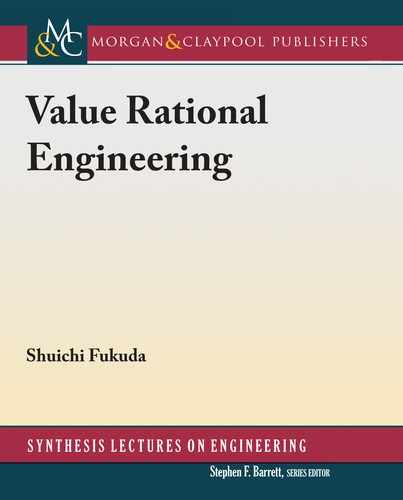
4.5. ABDUCTION: WHAT MATTERS IS THE GOAL 21
RAILROAD
In the case of a railroad (Fig. 4.2), we must select tracks to get to the destination (the goal). So,
it is important to select the right track. Among the choices, you choose the fastest way or the
cheapest way, whatever you like. Yes, you can optimize your journey to your goal. And you can
make decisions at the beginning.
Figure 4.2: Railroad.
VOYAGE
But in the case of an ocean voyage, the situation is completely different. It may be a fine day
today, but tomorrow a hurricane might attack us. In such a case, we need to drop anchor at a
port we did not plan to in order to escape from the hurricane. And in the worst case, we may
have to abandon the idea of getting to the port we initially planned to. en, we have to ask
ourselves why we set sail in the first place and what was our ultimate goal.
If we can achieve our ultimate goal, no matter where we may end our voyage, we are
happy. We do not care what port it may be. In other words, we should ask ourselves what port
will meet our expectation and achieve our ultimate goal. And we must remember that in the case
of a voyage, we must make decisions continuously to respond to the frequent changes (Fig. 4.3).
4.5 ABDUCTION: WHAT MATTERS IS THE GOAL
Interesting enough, Charles S. Peirce [13], American philosopher, logician, mathematician, and
scientist, proposed a very different logic, Abduction, which is often called e ird Logic. He is
known as the Father of Pragmatism and is one of the famous three founders of this philoso-
phy. e other two founders, William James and John Dewey, were psychologists. But Peirce is
logician, mathematician and scientist.

22 4. VALUE AND RATIONALITY: DEFINITIONS IN OTHER FIELDS
Figure 4.3: Voyage.
INDUCTION AND DEDUCTION
Induction and deduction are well known as logics. We accumulate experiences and structure
them into knowledge (induction). Once the knowledge is established, we can solve the problem
based on it (deduction). It may not be a quantitative approach as Simon’s rationality, but it is
reasonable enough to be called rational (Fig. 4.4).
ABDUCTION
But Peirce’s Abduction is based on trial and error. He does not care how reasonable the process
is. What matters to him is if the problem is solved or not, or the goal is achieved or not. e path
to get there does not matter. So, this is another very different framework of logic. His approach
proceeds as shown in Fig. 4.5.
First, you “abduct” some approach, which seems to work. en you apply it to the current
problem and observe. If it works, then it is fine. If not, then look for another one. Repeat this
cycle until a satisfactory result is found.
is does not agree with the other two well-known logics, induction and deduction. e
other two focus their attention on how reasonably the process or the approach is carried out.
Abduction does not. It focuses only on the goal.
Abduction may not sound reasonable, but if we do not know the path to the goal, there
is no other way, and in this sense, this Abduction approach is very much reasonable.
..................Content has been hidden....................
You can't read the all page of ebook, please click here login for view all page.
